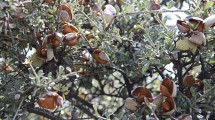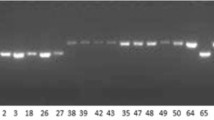Abstract
As part of the almond breeding programme at IRTA, we investigated the S genotypes of several cultivars using a combination of RNase zymograms, testcrosses, pollen-tube growth analysis and molecular identification by PCR analysis. For some of the cultivars examined, discrepancies appeared between their S alleles as reported in the literature and those found in this investigation, leading to a re-evaluation of their S genotypes. Analysis of the stylar ribonucleases (RNases), which are known to correlate with S alleles, of cvs. Achaak, Ardechoise, Desmayo Largueta, Ferrastar, Gabaix, Garbí, Glorieta, Languedoc, Primorskiy and Texas revealed inconsistencies with respect to the S5 and S10 alleles. However, PCR with the conserved primer pair AS1II/AmyC5R failed to detect any of these inconsistencies. When the S alleles from Desmayo Largueta, Gabaix, Primorskiy and Texas were sequenced, Texas and Primorskiy were found to carry the reported S5 allele, while Desmayo Largueta and Gabaix carried a new allele, which has been tentatively denoted as S25 This new S allele, previously reported to be S10, was also identified in Achaak, Ardechoise and Ferrastar. The proposed new S genotypes are Achaak (S2S25), Ardechoise (S1S25), Desmayo Largueta (S1S25), Ferrastar (S2S25) and Gabaix (S10S25). The S alleles of Garbí, Glorieta, Languedoc, Texas and Primorskiy remain as reported in the literature. Testcrosses in the field and laboratory confirmed the new S genotypes. One cultivar (Gabaix) could be assigned to the existing cross-incompatibility group O of unique genotypes, and two new groups were established (XVI and XVII) consisting of two cultivars each. The clarification of these S alleles will be useful in almond breeding programmes and for planning new commercial orchards in the future.




Similar content being viewed by others
References
Arús P, Olarte C, Romero M, Vargas FJ (1994) Linkage analysis of ten isozyme genes in F1 segregating almond progenies. J Am Soc Hortic Sci 119:339-344
Batlle I, Ballester J, Boskovic R, Romero MA, Tobutt KR, Vargas FJ (1997) Use of stylar ribonucleases in almond breeding to design crosses and select self-compatible seedlings. FAO-CIHEAM Netw Nuts Nucis Newsl 6:12-14
Boskovic R, Tobutt KR, Batlle I, Duval H (1997) Correlation of ribonuclease zymograms and incompatibility genotypes in almond. Euphytica 97:167-176
Boskovic R, Tobutt KR, Rovira M, Romero MA, Batlle I, Duval H, Dicenta F (1998) Inheritance of stylar ribonucleases in two almond progenies and their correlation with self-compatibility. In: Proc 2nd Int Symp Pistachios Almonds. Acta Hortic 470:118-122
Boskovic R, Tobutt KR, Duval H, Batlle I, Dicenta F, Vargas FJ (1999) A stylar ribonuclease assay to detect self-compatible seedlings in almond progenies. Theor Appl Genet 99:800-810
Boskovic R, Tobutt KR, Batlle I, Duval H, Martínez-Gómez P, Gradziel TM (2003) Stylar ribonucleases in almond: correlation with and prediction of incompatibility genotypes. Plant Breed 122:70-76
Broothhaerts W (2003) New findings in apple S-genotype analysis resolve previous confusion and request the re-numbering of some S-alleles. Theor Appl Genet 106:703-714
Channuntapipat C, Sedgley M, Collins G (2001) Sequences of cDNAs and genomic DNAs encoding the S1, S7, S8 and Sf alleles from almond, Prunus dulcis. Theor Appl Genet 103:1115-1122
Channuntapipat C, Collins G, Sedgley M (2002a) Self-compatibility of almond varieties Australian Nutgrower Sept-Nov 2002, pp 40-41
Channuntapipat C, Sedgley M, Batlle I, Arús P, Collins G (2002b) Sequences of the genomic DNAs encoding the S2, S9, S10 and S23 alleles from almond, Prunus dulcis. J Hortic Sci Biotechnol 77:387-392
Channuntapipat C, Wirthensohn M, Ramesh SA, Batlle I, Arús, P, Sedgley M, Collins G (2003) Identification of incompatibility genotypes in almond (Prunus dulcis Mill.) using specific primers based on the introns of the S-alleles. Plant Breed 122:164-168
Crossa-Raynaud P, Grasselly C (1985) Existence de groupes dinterstérilité chez lamandier. Coll GREMPA Thessalonique. Options Mediterr 1985-I:43-45
Doyle JJ, Doyle JL (1987) A rapid DNA isolation procedure for small quantities of fresh leaf tissue. Phytochem Bull 19:11-15
Duval H, Batlle I, Boskovic R, Tobbut KR (1998) Confirmation of incompatibility alleles in almond cultivars predicted by analysis of stylar ribonucleases. In: 10th GREMPA Seminar. Options Mediterr 33:25-27
Felipe AJ (1977) Estados fenológicos del almendro. Inf Tec Econ Agrar 8:8-9
Grasselly C (1972) Lamandier: caractères morphologiques et physiologiques des variétés, modalité de leurs transmissions chez les hybrides de première génération. PhD, Université de Bordeaux, Bordeaux, France
Hall TA (1999) bioedit: a user-friendly biological sequence alignment editor and analysis program for Windows 95/98/NT. Nucleic Acids Symp Ser 41:95-99
Heslop-Harrison J, Heslop-Harrison Y, Shivanna KR (1984) The evaluation of pollen quality, and a further appraisal of the fluorochromatic (FCR) test procedure. Theor Appl Genet 67:367-375
Ishimizu T, Endo T, Yamaguchi-Kabata Y, Makamura KT, Sakiyama F, Norioka S (1998) Identification of regions in which positive selection may operate in S-RNase of Rosaceae: implication for S-allele-specific recognition sites in S-RNase. FEBS Lett 440:337-342
Kester DE, Asay RA (1975) Almonds. In: Janick J, Moore JN (eds) Advances in fruit breeding. Purdue University Press, Indianapolis, pp 387-419
Kester DE, Gradziel TM, Micke WC (1994a) Identifying pollen incompatibility groups in California almond cultivars. J Am Soc Hortic Sci 119:106-109
Kester DE, Micke WC, Viveros M (1994b) A mutation in Nonpareil almond conferring unilateral incompatibility. J Am Soc Hortic Sci 119:1289-1292
Kester DE, Gradziel TM (1996) Almonds (Prunus). In: Moore JN, Janick J (eds) Fruit breeding. Wiley, New York, pp 1-97
López M, Alonso JM, Martínez-Gómez P, Socías I Company R, Gradziel TM, Batlle I (2001) Biological and molecular assessment of self-incompatibility in almond. FAO-CIHEAM Netw Nuts Nucis Newslett 10:8-11
López M, Mnejja M, Romero MA, Vargas FJ, Batlle I (2004) Use of Sf specific PCR for early selection of self-compatible seedlings in almond breeding. In: 12th GREMPA Meet. Mirandela (in press)
Ma R, Oliveira MM (2001) Molecular cloning of the self-incompatibility genes S1 and S3 from almond (Prunus dulcis cv. Ferragnès). Sex Plant Reprod 14:163-167
Martínez-Gómez P, López M, Alonso JM, Ortega E, Batlle I, Socías and Company R, Dicenta F, Dandekar AM, Gradziel TM (2003a) Identification of self-incompatibility alleles in almond and related Prunus species using PCR. In: 26th ISHS Int Hortic Congr. Acta Hortic 622:397-401
Martínez-Gómez P, Arulsekar S, Potter D, Gradziel TM (2003b) An extended interspecific gene pool available to peach and almond breeding as characterized using simple sequence repeat (SSR) markers. Euphytica 131:313-322
Mnejja M, López M, Romero MA, Vargas FJ, Batlle I (2002) Cross design for self-compatibility in almond breeding using stylar ribonucleases. In: 3rd Int Symp Pistachios Almonds and 12th GREMPA Colloq. Acta Hortic 591:233-238
Ortega E (2002) Mejora genética del almendro: nuevas estrategias para la obtención de variedades autocompatibles. CSIC, Centro de Edafología y Biología Aplicada del Segura. PhD thesis, Universidad de Murcia, Spain
Ortega E, Dicenta F (2003) Inheritance of self-compatibility in almond: breeding strategies to assure self-compatibility in the progeny. Theor Appl Genet 106:904-911
Page RDM (1996) Treeview: an application to display phylogenetic trees on personal computers. Comput Appl Biosci 12:357-358
Rovira M, Clavé J, Romero M, Santos J, Vargas FJ (1998) Self-compatibility in almond progenies. In: Proc 2nd Int Symp Pistachios Almonds. Acta Hortic 470:66-71
Sonneveld T, Tobutt KR, Robbins TP (2003) Allele-specific PCR detection of sweet cherry self-incompatibility (S) alleles S1 to S16 using consensus and allele-specific primers. Theor Appl Genet 107:1059-1070
Tamura M, Ushijima K, Sassa H, Hirano H, Tao R, Gradziel TM, Dandekar AM (2000) Identification of self-incompatibility genotypes of almond by allele-specific PCR analysis. Theor Appl Genet 101:344-349
Tao R, Yamane H, Sassa H, Mori H, Gradziel TM, Dandekar AM, Sugiura A (1997) Identification of stylar RNases associated with gametophytic self-incompatibility in almond (Prunus dulcis). Plant Cell Physiol 38:304-311
Thompson JD, Gibson TJ, Plewniak F, Jeanmougin F, Higgins DG (1997) The clustalX windows interface: flexible strategies for multiple sequence alignment aided by quality analysis tools. Nucleic Acids Res 24:4876-4882
Van Nerum I, Geerts M, Van Haute A, Keulemans J, Broothaerts W (2001) Re-examination of the self-incompatibility genotype of apple cultivars containing putative new S-alleles. Theor Appl Genet 103:584-591
Vargas FJ (1975) El almendro en la provincia de Tarragona. Diputación Provincial de Tarragona
Viruel MA (1995) Construcción de un mapa genético con marcadores moleculares en almendro (Prunus amygdalus Batsch.). Estudio de la variabilidad intraespecífica y aplicación a la identificación varietal. PhD thesis, IRTA, Departament de Genètica Vegetal, Universitat de Barcelona, Barcelona, Spain
Wiersma PA, Wu Z, Zhou L, Hampson C, Kappel F (2001) Identification of new self-incompatibility alleles in sweet cherry (Prunus avium L.) and clarification of incompatibility groups by PCR and sequencing analysis. Theor Appl Genet 102:700-708
Acknowledgements
The authors are grateful to P. Martínez-Gómez (CEBAS, CSIC, Murcia) and T.M. Gradziel (University of California, Davis, USA) for their valuable comments and suggestions. We also thank J. Clavé, M.A. Romero, J. Santos and J. Vergés (IRTA-Mas Bové), D. Gregory and K. Malone (University of Adelaide, Australia) and members of the laboratory of Genètica Vegetal at IRTA-Cabrils for their help with the field and laboratory work. This research was conducted under two INIA (Spanish Ministry of Education and Science) Projects (SC97-049 and RTA01-081). M.L. gratefully acknowledges a grant from the INIA postgraduate programme.
Author information
Authors and Affiliations
Corresponding author
Additional information
Communicated by H.F. Linskens
Rights and permissions
About this article
Cite this article
López, M., Mnejja, M., Rovira, M. et al. Self-incompatibility genotypes in almond re-evaluated by PCR, stylar ribonucleases, sequencing analysis and controlled pollinations. Theor Appl Genet 109, 954–964 (2004). https://doi.org/10.1007/s00122-004-1656-2
Received:
Accepted:
Published:
Issue Date:
DOI: https://doi.org/10.1007/s00122-004-1656-2




